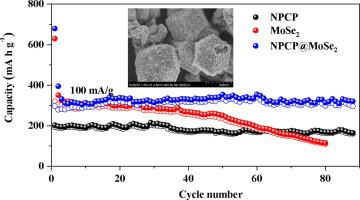Journal of Colloid and Interface Science ( IF 9.4 ) Pub Date : 2021-05-12 , DOI: 10.1016/j.jcis.2021.05.050 Qingqing Jiang 1 , Lin Wang 2 , Yan Wang 2 , Meihua Qin 2 , Rui Wu 2 , Zhengxi Huang 2 , Hai-Jian Yang 2 , Yongxiu Li 2 , Tengfei Zhou 3 , Juncheng Hu 2

|
For potassium-ion battery (PIB), it remains a huge challenge to develop an appropriate anode material to compensate the large radius of K+. MoSe2 shows great potential for efficient K+ insertion/extraction due to its unique lamellar structures with an interlayer spacing of 6.46 Å. However, pure MoSe2 has low electronic conductivity and agglomerates during long-term cycling. In the present work, MoSe2 nanosheets were fabricated on the N-doped porous carbon polyhedron (NPCP). The obtained product was designated as NPCP@MoSe2 and functioned as anode materials for PIBs. NPCP@MoSe2 displayed a promising reversible capacity (325 mAh/g at 100 mA/g after 80 cycles), long-term cycling performance (128 mAh/g at 500 mA/g after 800 cycles), and superior rate property at 5000 mA/g. The enhanced electrochemical performance of NPCP@MoSe2 could be attributed to the rational design of hybrid structures. Notably, the hollow NPCP provide a large contact area for the interactions among the electrolytes and electro-active materials as well as partly buffer the volume expansion. The synergistic effects between MoSe2 and NPCP could mitigate the agglomeration of MoSe2 nanosheets. Besides, the uniformly doping N elements enhanced the conductivity of the carbon matrix, and the N-group also provided potential binding active sites for K-ion accommodation. This work paves the ideas for the design of novel anode materials with high specific capacity, good cycling stability and outstanding rate capability for PIBs.
中文翻译:

MoSe 2纳米片包覆的MOF衍生的N掺杂的多孔碳多面体用于钾存储的合理设计
对于钾离子电池(PIB),开发合适的负极材料以补偿K +的大半径仍然是一个巨大的挑战。MoSe 2由于其独特的层状结构(层间间距为6.46Å)而具有高效K +插入/提取的巨大潜力。然而,纯的MoSe 2具有低的电子电导率并且在长期循环过程中附聚。在目前的工作中,MoSe 2纳米片是在N掺杂的多孔碳多面体(NPCP)上制成的。所得产物命名为NPCP @ MoSe 2并用作PIB的阳极材料。NPCP @ MoSe 2显示出令人鼓舞的可逆容量(80个循环后100 mA / g时为325 mAh / g),长期循环性能(800个循环后500 mA / g时为128 mAh / g)和5000 mA / g的优异速率特性。NPCP @ MoSe 2电化学性能的提高可归因于混合结构的合理设计。明显地,中空NPCP为电解质和电活性材料之间的相互作用提供了大的接触面积,并且部分地缓冲了体积膨胀。MoSe 2和NPCP之间的协同效应可以减轻MoSe 2纳米片的团聚。此外,均匀掺杂的N元素增强了碳基体的电导率,而N-group还提供了潜在的有约束力的活性位点,用于K-离子调节。这项工作为具有高比容量,良好的循环稳定性和出色的PIB倍率性能的新型阳极材料的设计铺平了思路。





































 京公网安备 11010802027423号
京公网安备 11010802027423号